-
Metal grinding... choosing the right disc for the job.
May 26, 2020
Metal grinding... choosing the right disc for the job.
Ask anyone who works with metal, and they are sure to tell you that grinding is an essential process in metal fabrication, providing an efficient and effective method to shape and finish metals. Grinding is an abrasive machining process that uses a grinding wheel as the cutting instrument connected to a power tool, typically an angle grinder. It allows skilled craftsmen to remove and shape metal from their workpieces, clean up cuts, ready metal for welding and to grind out welds. However, there is more to the humble grinding wheel than meets the eye. As the need for higher quality finishes on a variety of substrates increases, choosing the correct grinding wheel for the broad range of metal grinding applications and processes becomes critical.
How grinding wheels work.
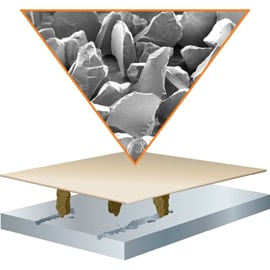
Conventional Grains 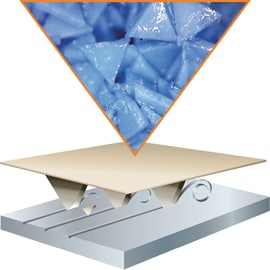
3M Precision-Shaped Grains Grinding wheels can get complicated. They are available in a variety of sizes, shapes and grits, natural or synthetic abrasive minerals as well as the type of bonding material used to fuse the abrasives to the surface of the wheel itself. However, the most important aspect to effective grinding wheels and their workings are the abrasive grains they employ. The abrasive materials spread throughout the wheel are hard, sharp, mineral grains that are found in nature or are man-made, and are strong enough to allow the wheel to grind the metal through friction. However, with the advancements in abrasive technology, not all abrasives are created equally. There are alternatives that utilise precision-shaped ceramic grains that pave the way to significant performance improvements to grind faster, last longer and deliver a better finish.
Grinding wheels are manufactured with either conventional grains or precision-shaped grains. Conventional grains can be inefficient, precision-shaped grains, on the other hand, are designed to last longer, stay sharper for longer, grind or cut faster and run cooler for maximum efficiency and productivity. So what is the difference? The following section evaluates the disparity in abrasive grains, in greater depth.
Conventional grains
Since most abrasive grains are manufactured with conventional crushing and screening techniques, rather than mined, they come in particles of various shapes and sizes. When these grains are coated onto an abrasive backing, the result is a random distribution of grain that is irregular in shape and size. This irregular cutting surface results in a “ploughing” effect as it cuts through the material. This ploughing causes heat to build up in the workpiece and the abrasive, which dulls the grain, causing it to cut more slowly, reduce consumable life and add time to the grinding process.
Precision-shaped grains
Comprised of similarly sized triangles precision-shaped grains fracture as they wear to expose new sharp edges that cut cleanly, instead of gouging or ploughing through the metal. This action prevents heat from building up in the workpiece – reducing heat-related stress cracks and discolouration. Furthermore, because the abrasive itself stays cooler and sharper, it lasts longer than conventional grain.
The science of precision-shaped grain.
Pioneered by 3M, this revolutionary breakthrough technology capitalised on two core technologies: microreplication and ceramics. Microreplication technology uses tiny, precisely shaped structures to give materials new physical or optical properties to produce small three-dimensional precision-shaped grains that structurally resemble triangles. First introduced in 2009 in a range of fibre discs and belts, their geometry creates a precise and consistent abrasive surface that is ideal for metal finishing applications.
Crafted from uniformly sized triangles of ceramic aluminium oxide, 3M precision-shaped grains are designed to break away as they wear, continuously forming new sharp points and edges, resulting in a self-sharpening effect. These grains wear evenly, are more durable and consistently slice through metal like a knife, instead of gouging or ploughing.
The video below illustrates how precision-shaped grain stacks up against conventional grains to increase efficiency and productivity.
Experience grinding reinvented... 3M precision-shaped grain grinding solutions.
Grinding is the foundation of metalworking and 3M has the cutting-edge abrasive products you need for every stage of the process, including weld grinding, beveling, gate removal and even cylindrical grinding. 3M™ Cubitron™ II and Silver Abrasives with 3M Precision-Shaped Grain technology were developed to ensure you are wearing away metal, not your body. They run cooler and grind longer due to their continuously fracturing precision-shaped grains to:
- Increase productivity
- Enhance product life
- Decrease change over and downtime
- Reduce the risk of operator fatigue and injury
- Minimise overall abrasive consumable spend or usage
With abrasive belts, grinding wheels, fibre and flap discs engineered specifically for grinding processes, 3M has a product to suit your specific needs. These products remove metal and level welds without overheating or prematurely wearing down. Choosing the right product format for your grinding needs is just as important as using quality consumables, both of which will help you get through the toughest of jobs for the best possible grinding results. Three of the main styles used are depressed centre grinding wheels, fibre discs, and flap discs. Below is a summary on each of these right-angle abrasive products and when they should be used.
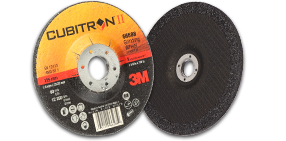
Depressed centre grinding wheels
Depressed centre discs have a long abrasive life and handle the toughest of surfaces. However, they generally have a slower cut-rate than fibre and flap discs, provide a coarser finish, and are the least forgiving - inexperienced operators may gouge the substrate.
- Longest life
- Handles toughest surfaces
- Slower cut rate
- Coarsest finish
- Least forgiving
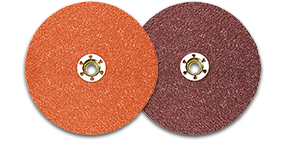
Fibre disc grinding wheels
Fibre discs are the right choice when speed is your goal. Fibre discs are the fastest product for rapid stock removal. While they don’t offer the life of a grinding wheel, in many cases, they are the most cost-effective product format when considering the time savings and overall cost.
- Fastest method
- Medium finish
- Lowest overall cost
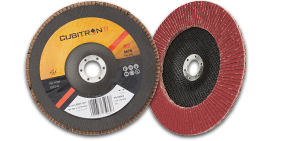
Flap disc grinding wheels
Flap discs offer versatility and ease of use to deliver a precise finish with ease, excellent when substrate damage needs to be avoided. The finish produced helps to reduce process steps and the total number of abrasive discs used.
- Most user friendly
- Finest finish
- Most forgiving
- Most versatile

Work smarter, finish faster, regardless of your application, 3M has an abrasive solution to suit your application. For more information about grinding wheels with 3M Precision-Shaped Grain technology to meet the needs of your specific application and to help you make the right choice, view our catalogue and explore the complete precision-shaped grain abrasives family.
Precision-Shaped
Grain Abrasives
CatalogueAlternatively explore our Metalworking and Metal Fabrication page, or contact your 3M Abrasive System Specialist.
